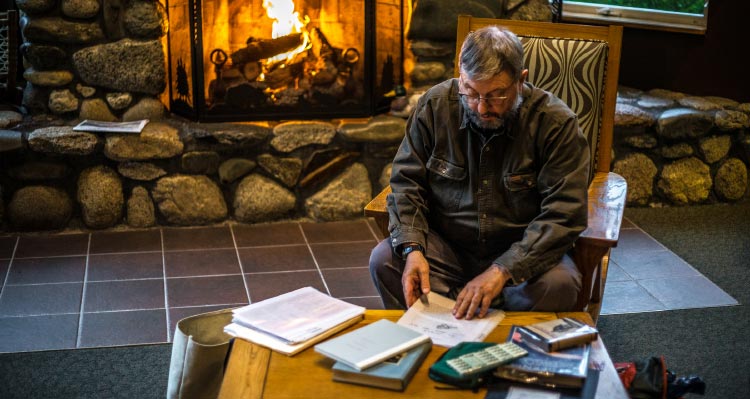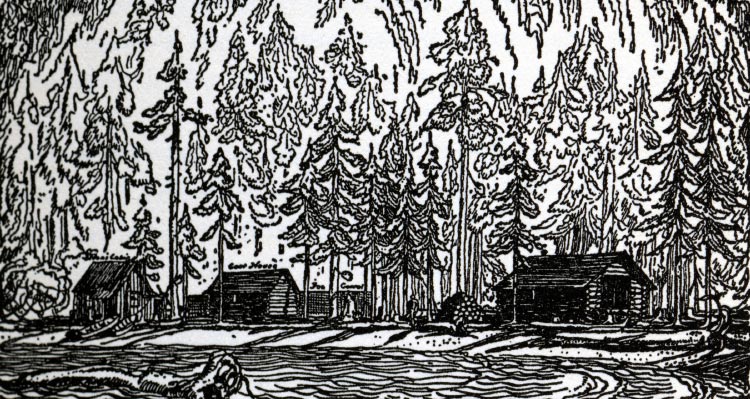The allure of quiet contemplation is timeless and universal. For historian and writer Doug Capra, the story of Rockwell Kent's winter on Fox Island was simply irresistible.
As someone deeply connected with both the location of Kent's adventure in coastal Alaska and with the appeal of the wilderness to a person's psyche, Capra has spent nearly 30 years researching and writing about Rockwell Kent. An American illustrator, painter, print-maker, writer and adventurer, Kent has been the subject of numerous books, articles, films and academic projects over the years. That's because he was both extremely prolific and deeply attractive as a research subject. Kent had a strong political and activist voice and yet he was drawn to transcendentalism and mysticism—a multi-faceted character with a dynamic life story! Rockwell Kent was an incredibly varied human being who lived grand adventures.
Early on, though, Capra noticed what he calls a 'vacuum'—no writers or scholars had seriously researched Kent's time in Alaska.

"As a writer, and someone who is interested in history and biography, that’s a place you want to go—where there’s not a lot of information," he says. "And then you become more fascinated with the individual."
In addition to many articles about Kent, Capra has written the forewords for two of Kent’s Alaska books and a play about the painter. His book, The Spaces Between: Stories from the Kenai Mountains to the Kenai Fjords, contains two chapters about Kent.
Kent is the kind of subject that can make a writer giddy—he was complex, imperfect, always striving for more and constantly evolving. After his restorative time on Fox Island, Kent returned to New York and made a splash with his work. His memoir of his time in Alaska, Wilderness: A Journal of Quiet Adventure in Alaska, was the first of several books and got the attention of galleries, publishers and the press.

A retired teacher, Doug Capra has written two books about Alaska history and worked for nearly 20 years as a seasonal ranger in Kenai Fjords National Park. Like Kent, he became very interested in the whole concept of wilderness—What is wilderness? Why are people so attracted to it? What does wild mean? He began to realize that Kent's art from Alaska and his memoir Wilderness are as relevant today as ever.
"There’s just something intriguing about him. He lived a good part of the 20th Century and was involved in so many activities," he says.
Ultimately, for Doug Capra, the allure of Kent's story is a personal one as well. "I'm in search of the same kind of quiet adventure that Kent was looking for here," he says.

In the late 1910s, Alaska was frequently in the news in New York City because of the railroad being built. Seward was the starting point for that large project. Kent was always drawn to wild places. Although he was based in New York City for much of his life, he'd previously dragged his family to remote Newfoundland, Greenland and coastal Maine. A great Alaska adventure was the next step.
Once they arrived on steamship in Seward from Seattle, they set out in an 18-foot dory loaded with 100 pounds of supplies and aimed for an island they'd heard about from locals, Fox Island. Olson, an “old Swede” they’d met in town, towed their dory to Fox Island, showed them around the fox farm, and encouraged them to spend the winter with him. Throughout the winter, they rowed back and forth to Seward, 12 miles away, a handful of times in that same precarious dory.
With the help of Olson, who ran an established fox farm on land leased from the federal government, they were meticulous with their supplies. It was a harsh winter. Still, for Christmas dinner, Kent prepared an elaborate celebration for his son and Olson, including Christmas presents and plum pudding.

When Kent first arrived on Fox Island, he was without his cherished canvasses, which had been delayed in the US Post. So he did a lot of pen and ink sketching as well as oil painting impressions on plywood. He was also writing his memoir, Wilderness: A Journal of Quiet Adventure in Alaska, which features many outstanding pen and ink drawings. It was published in 1920 and the New Statesman later called it "easily the most remarkable book to come out of America since Leaves of Grass was published." That same year he published his book Wilderness. It was the combination of the book and the paintings that really called attention to Kent as an artist.
Kent returned to New York in the spring of 1919, loaded with artistic inspiration and sketchbooks that would provide the basis for many paintings. He quickly drew the attention of the New York art and publishing world. The 1920 exhibition of his Alaska work at the Knoedler Galleries in New York City, coupled with the publication of Wilderness that same year, really called attention to Kent as an artist, according to Doug Capra.
When Rockwell Kent died in 1971, The New York Times called him "...a thoughtful, troublesome, profoundly independent, odd and kind man who made an imperishable contribution to the art of bookmaking in the United States." He was revered for his political activism and his creative mind. His time on Fox Island remains a key high point in his life. His work from that time is in the Hermitage Museum in St. Petersburg, Russia, the Anchorage Museum and at the Rockwell Kent Archives and Gallery in Plattsburg, New York, among other locations.
Learn more about Kent’s experience on Fox Island by watching Quiet Adventure and find out how to have your own "Quiet Adventure".
Insider tips, inspiration and deals — delivered straight to your inbox.